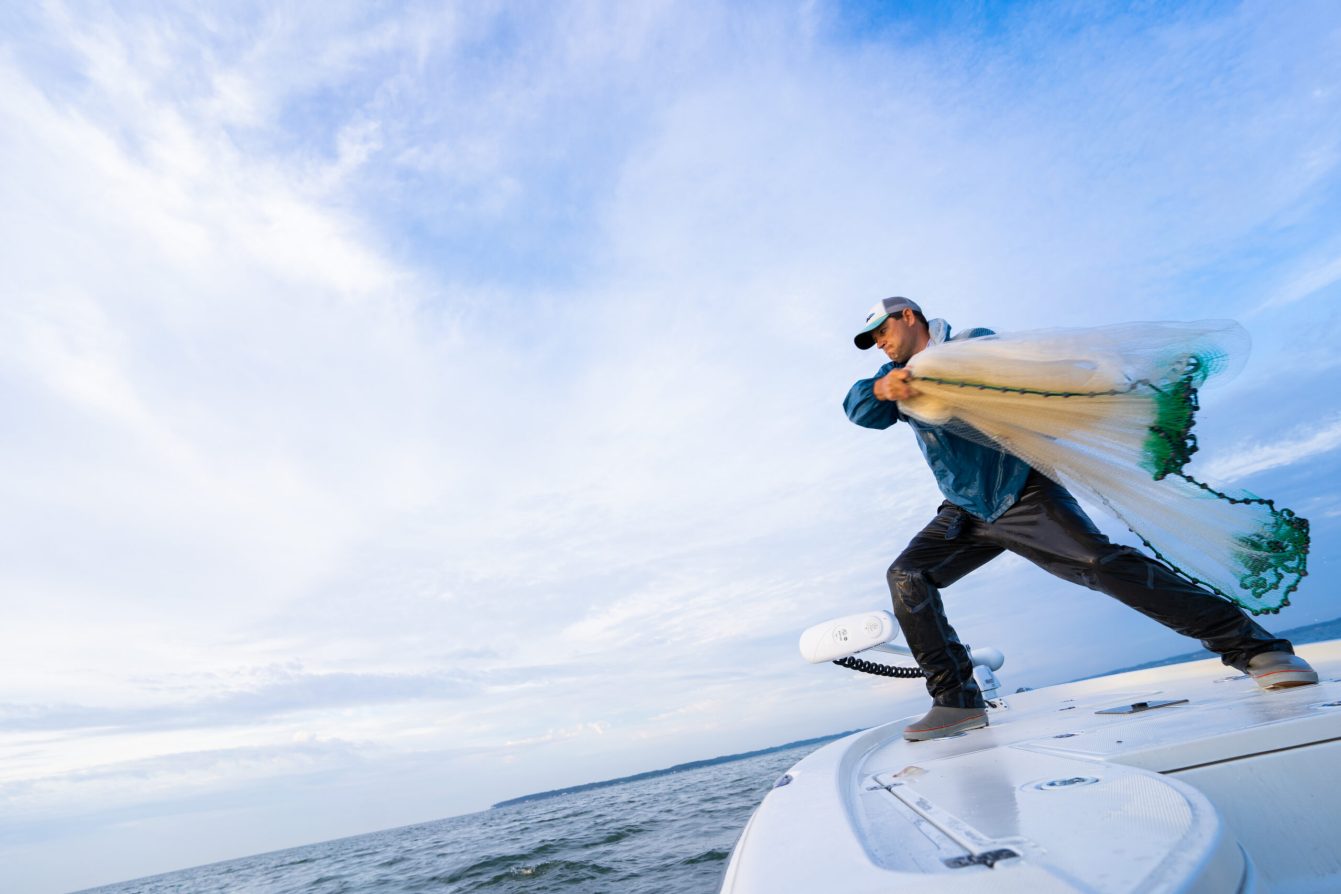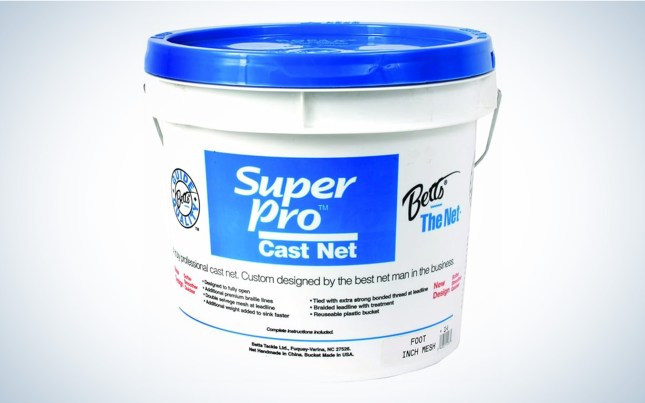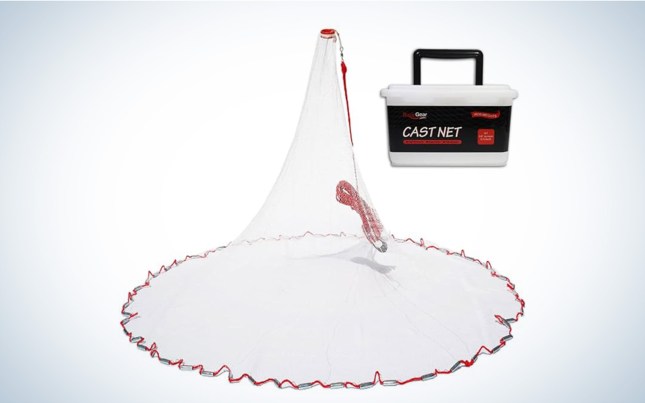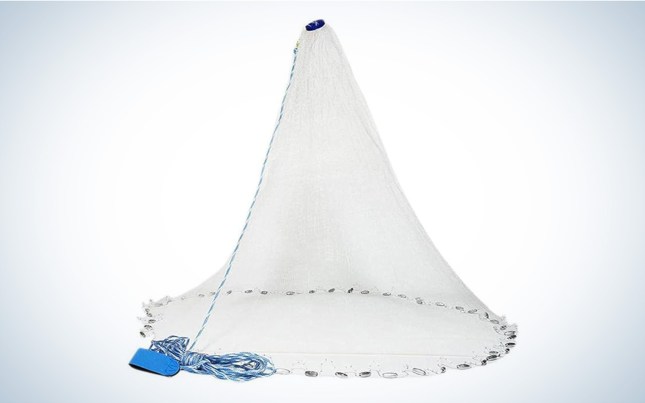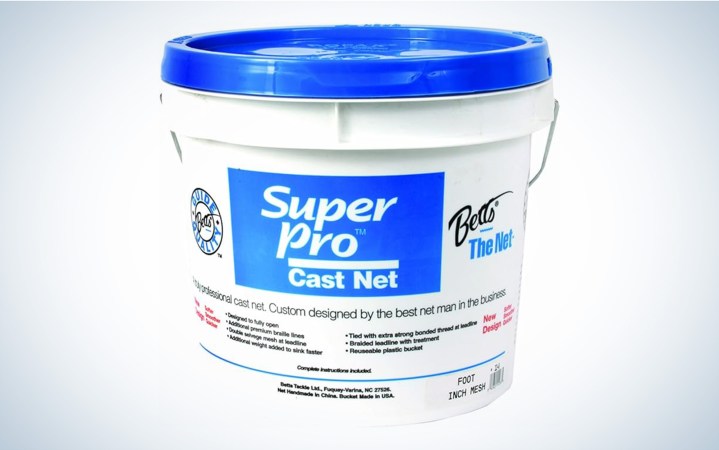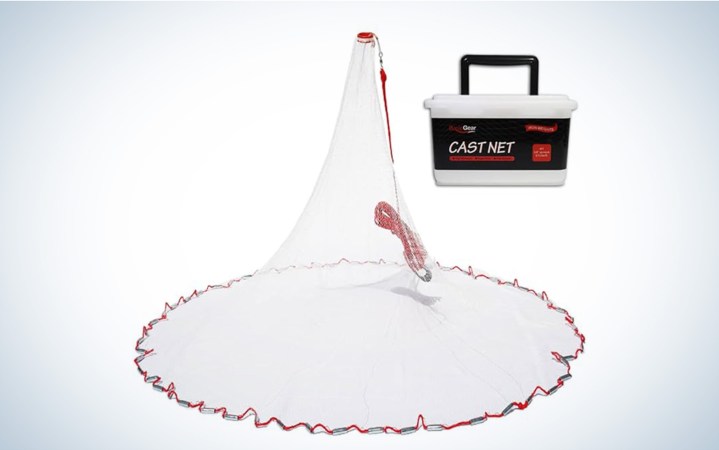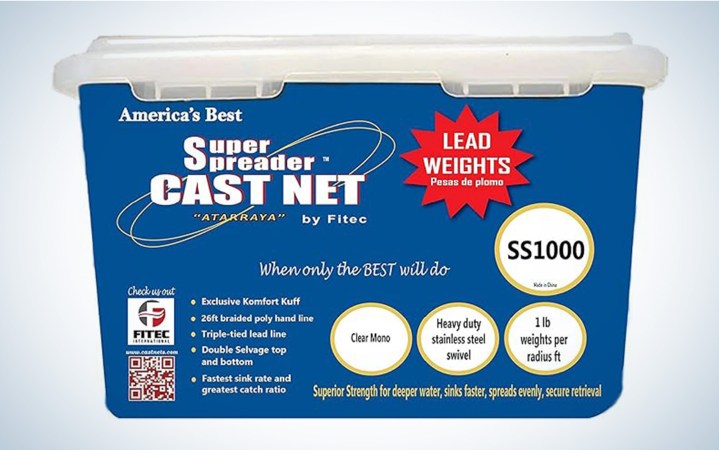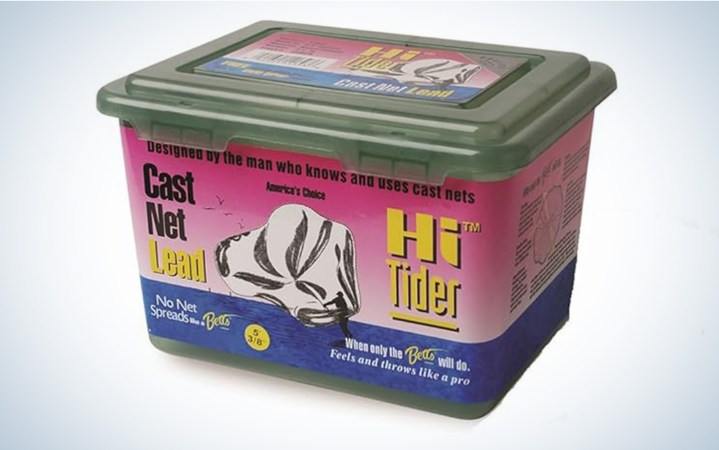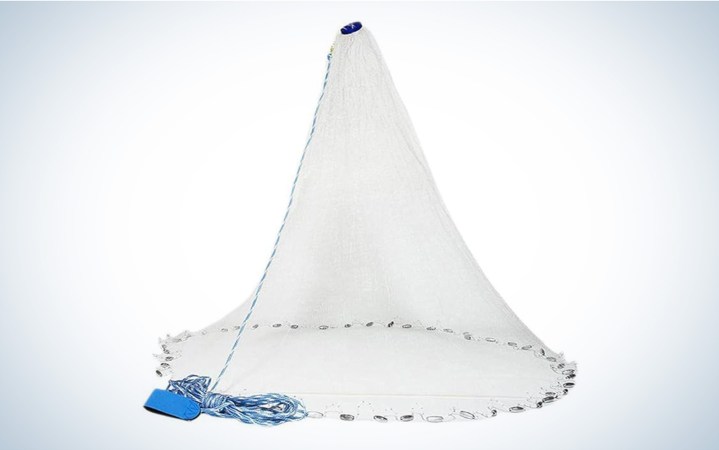We may earn revenue from the products available on this page and participate in affiliate programs. Learn More ›
Employing frisky live bait indigenous to the water fished is almost always the most effective way to catch fish in fresh and saltwater. Bait shops do a good job of providing live baitfish or shrimp to anglers. But catching your own bait with a cast net eliminates the need for time-consuming trips to a shop, as well as the transport hassle and need for special mobile bait tanks — plus it saves money.
I’ve used cast nets to catch bait in saltwater and freshwater from New England to the Far West, as well as in Midwest and Southern waters. For nearly 50 years I’ve lived in Florida, where cast netting bait is a core tenet of fishing. I’ve taught my children and grandchildren (as young as age 6) how to throw and use a cast net. They’ve all excelled at it and enjoy it — netting everything from wild shiners and shad to mullet, menhaden, sardines, pilchards, and coolers full of lively, hefty shrimp. Having a cast net readily available is a must for much fishing, and every boat of the many I’ve owned has always had a cast net stowed on board and ready for use. After testing several of the best options on the market here are my picks for the best cast nets.
- Best Overall: Betts Super Pro Cast Net
- Best Bargain: Basic Gear Cast Net
- Best for Shallow Water: Fitec Super Spreader
- Best Balanced and Fast-Sinking: Betts Hi Tider
- Best for Beginners: Yeahmart Handmade American Saltwater Fishing Cast Net
How I Tested the Best Cast Nets
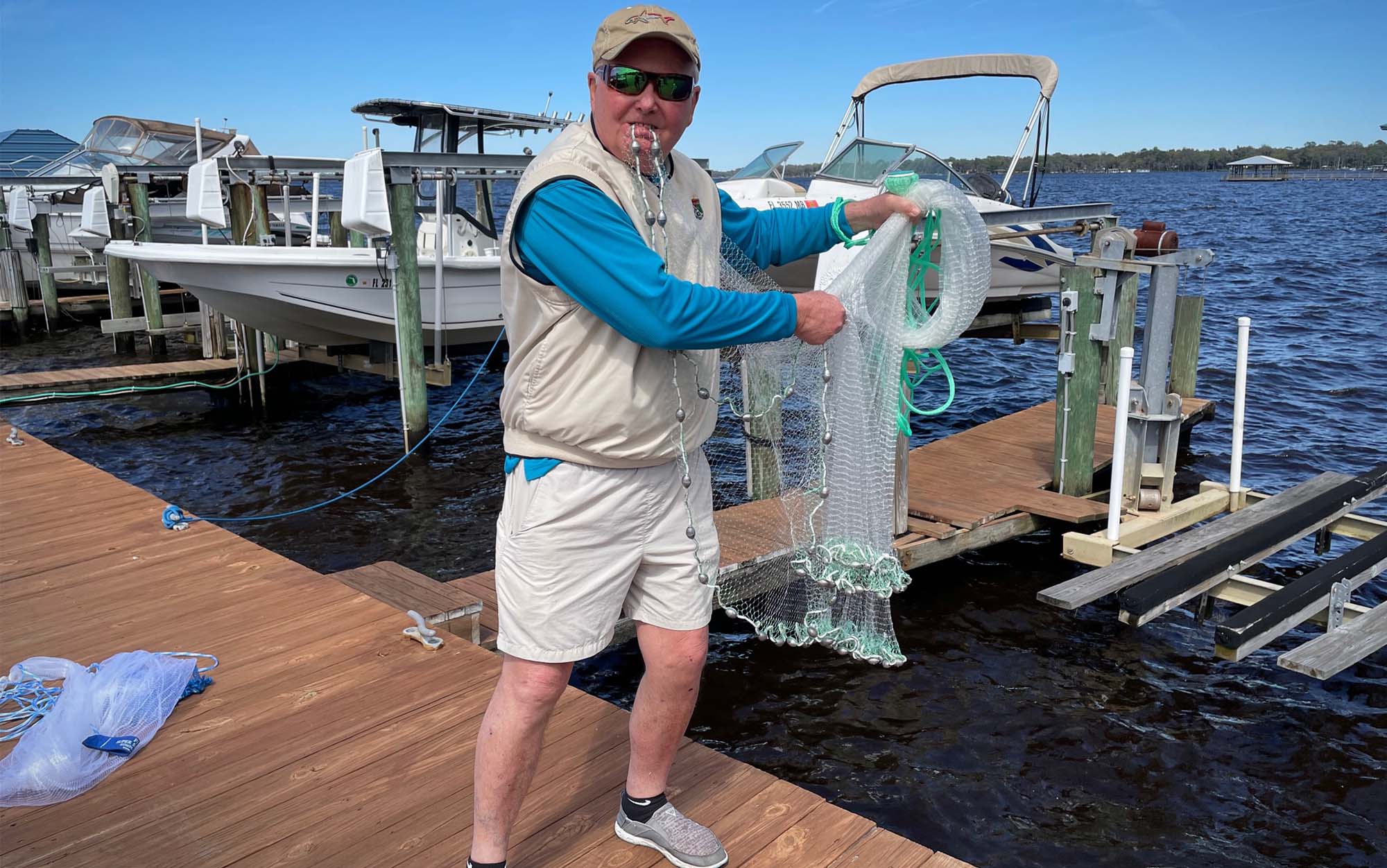
Bob McNally
I’ve used and owned so many throw nets of sizes small and large that I can’t honestly keep track of them. I’ve tossed hand-made and heavy nets of massive 12-foot lengths and bargain store small ones just a few feet in radius. Cast nets can be very focused in their design, but for this test, I focused on general smaller nets that are easier to throw. The test models had about a 6-foot radius and not a lot of lead-line weight. Those specs made them effective in water 3 to 10 feet deep.
I threw nets off a large and stable marina boat dock. This allowed for easy observations of how nets worked in use. As I threw them, I evaluated them on:
- Ease of throw
- Consistency of opening
- Sink rate
- Build quality
Best Cast Nets: Reviews & Recommendations
Best Overall: Betts Super Pro Cast Net
Key Features
- Six panel net
- Rounded, heavy, snag-resistant sinkers in lead line
- Nylon braided hand line
- Additional braille lines for sure net closers
- Large plastic bucket for net storage
- Price: $123
Pros
- Leads are rounded and very secure to net with double selvage connections
- Mesh is clear mono, soft, and supple
- A serious cast net that sinks fast
- Made to last for many years with proper care
Cons
- At almost 10 pounds it’s too heavy for some people to handle and throw well
Betts is arguably the biggest name in commercially made cast nets in the USA, and this net does the company proud. If a net can be “overbuilt,” this one may be it, at least for casual anglers who want to catch bait on occasion. Because this Betts net is so well made, it could last much of a lifetime if cared for. With regular use, cast nets get into all kinds of watery problems — from dragging bottom in shells and rocks to fouling in brush and logs. This net can take that abuse better than most on the market. For that, anglers pay a premium. But this is a top choice if you often fish in a rugged environment and need a reliable net that can be used about anywhere.
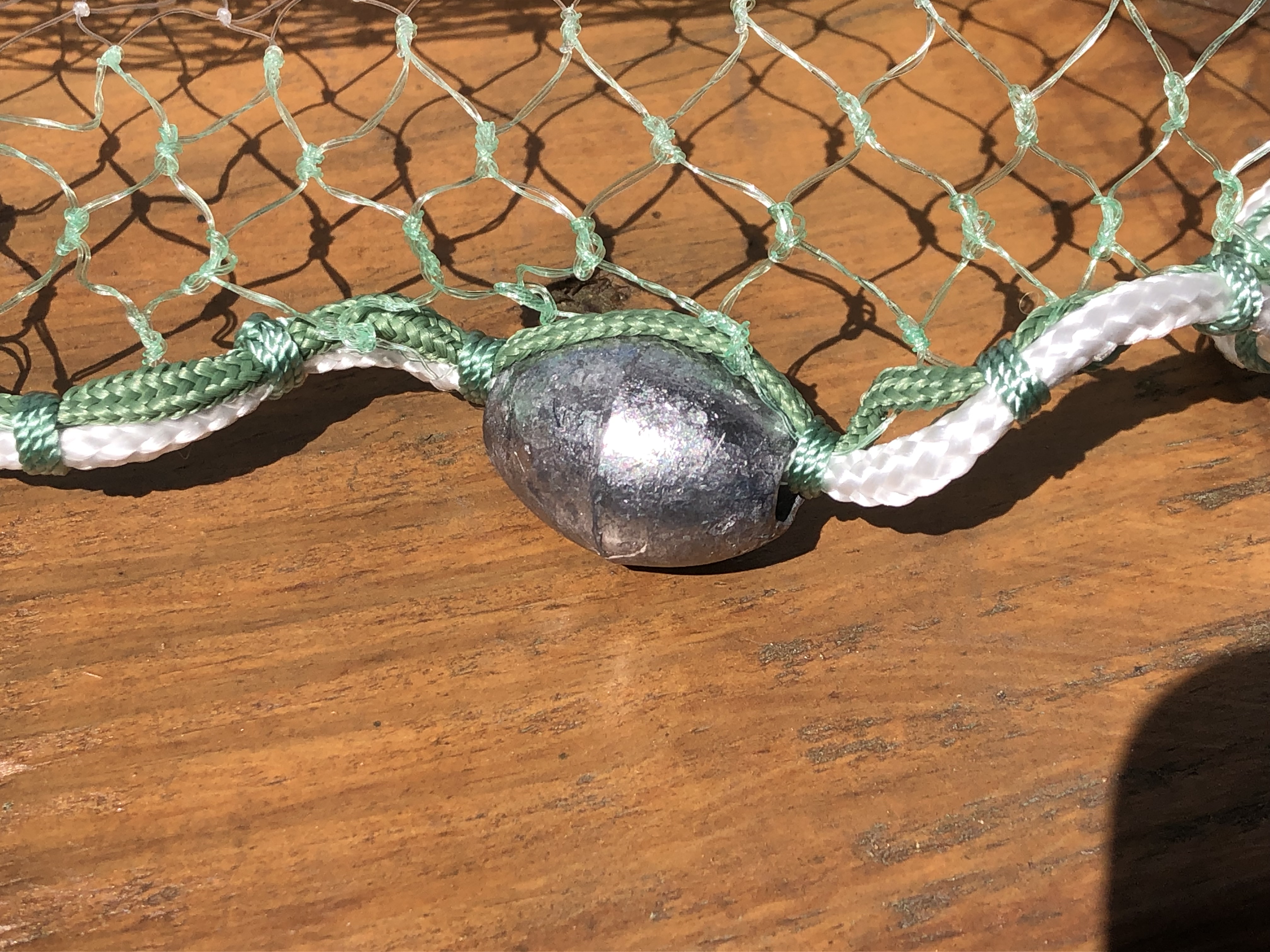
Bob McNally
The extra rounded leads in the net and the ½-inch openings allow the net to get down quickly. That’s a plus when trying to catch spooky bait in clear and deeper water. Heavy, rounded leads that are only a few inches apart make a tight “seal” on the bottom around so the bait can’t escape. The weight’s shape and spacing also make it throw well.
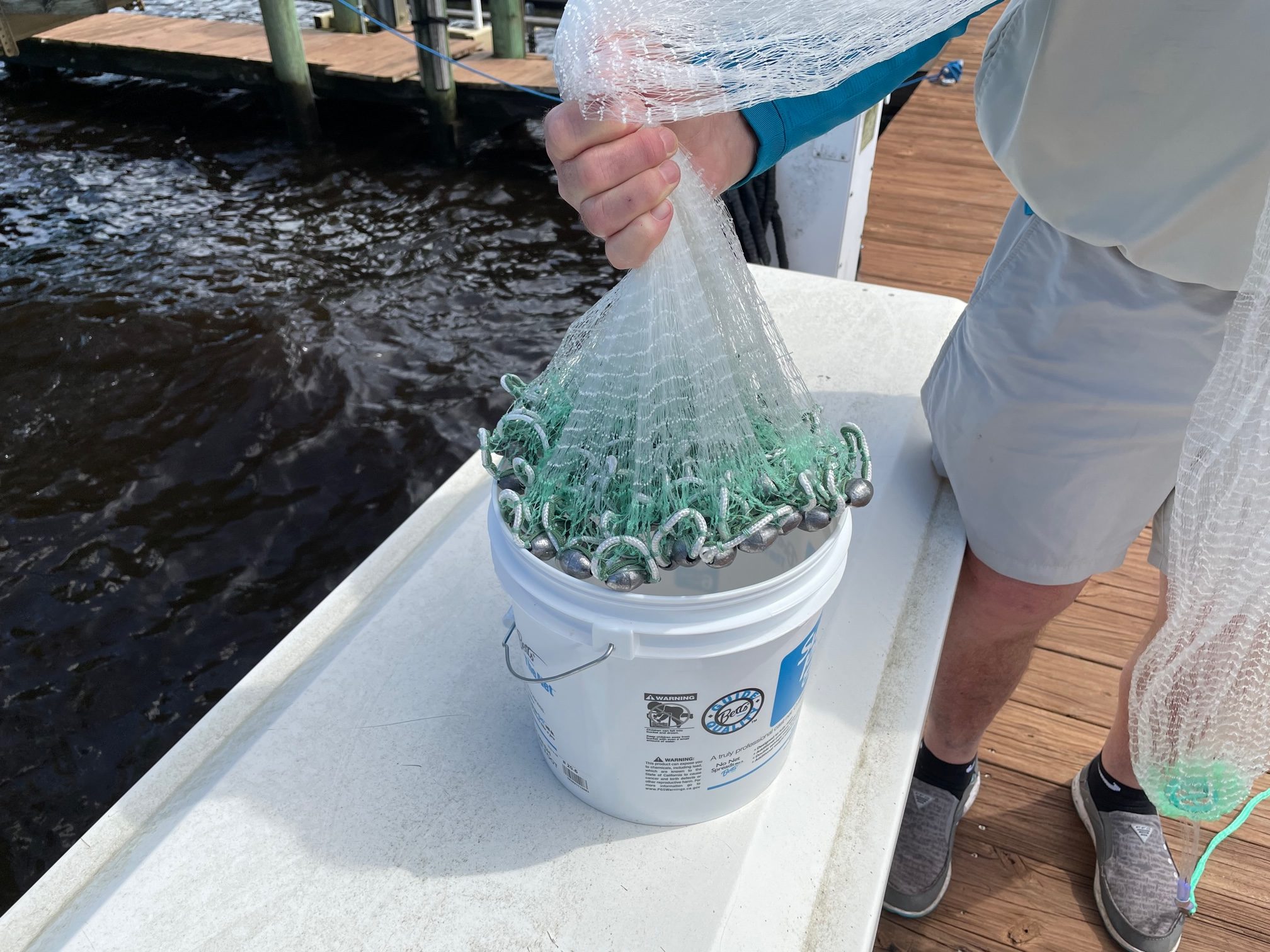
Bob McNally
Because this Betts net is rather heavy, throwing the net on a stable surface like a dock or bridge is easier than standing on a slick boat deck in rolling swells while searching for bait schools. The net comes in a great plastic carry bucket that makes storage convenient. But anglers should be certain to hang and dry the net before stowing it in the air-tight container. Otherwise, it may dry rot over time.
Read Next: The Best Live Baits
Best Bargain: Basic Gear Cast Net
Key Features
- Padded wrist strap
- Zinc-iron 1.5-inch pencil style lead weights
- 3/8-inch clear mono mesh
- Repair kit
- Price: $30
Pros
- A rather light weight of under 5 pounds makes it easy to throw
- Lightweight, 3/8-inch mesh is choice for shallow water use
- Repair kit for mesh holes mending, plus a spare lead line sinker
- Durable stainless swivel connecting throw line to brailles
Cons
- The wrist strap is soft, but small, an adult hand may have trouble fitting through it
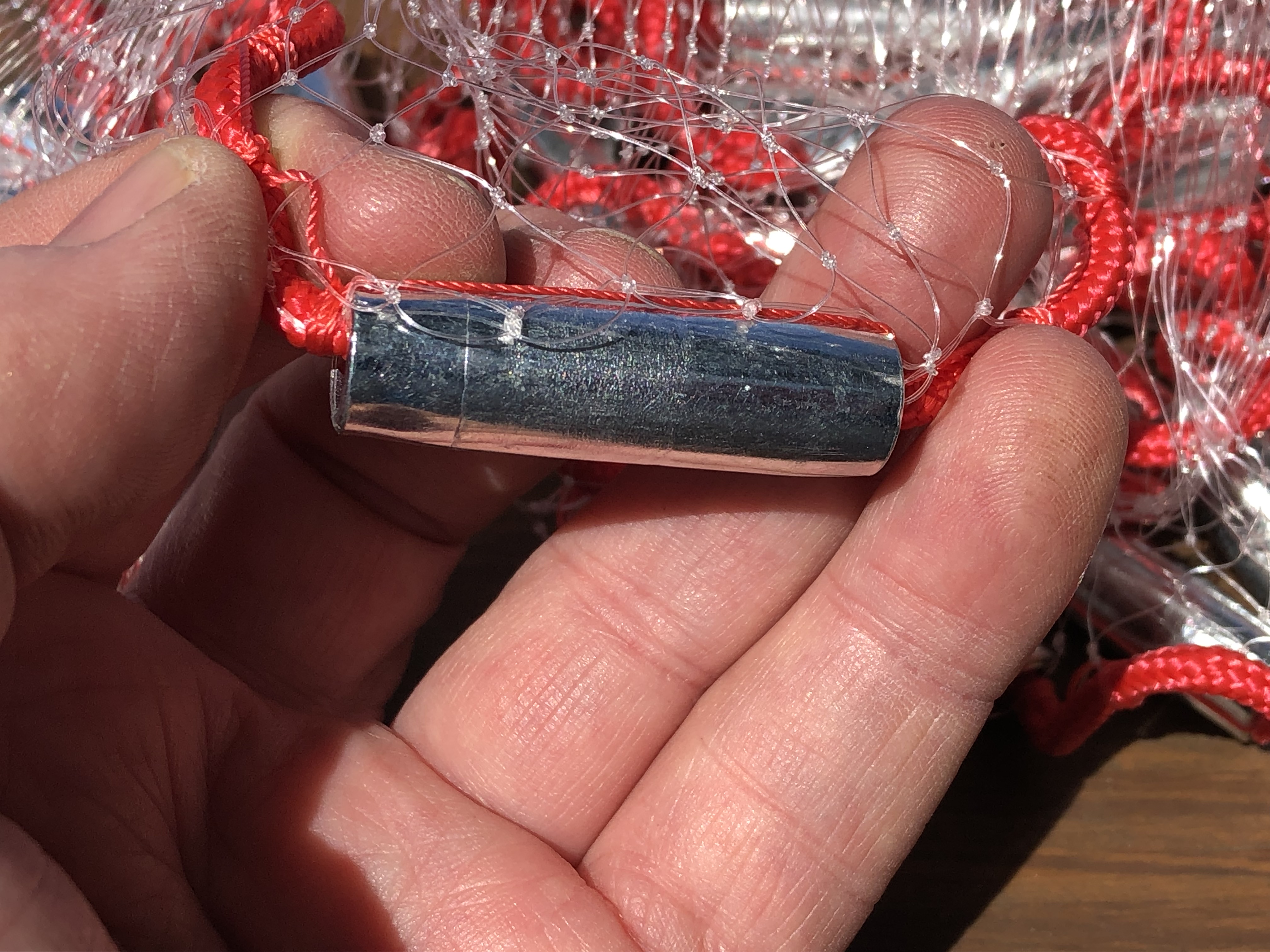
Bob McNally
This is a great net for small-stature anglers because it’s lightweight and can be tossed far with ease. That’s a winner for those after shrimp from a dock or getting shiners in a pond. But for deeper water work, other nets are more suitable. Yet for the price, this one is a bargain any way you look at it. The pencil-shaped lead line is good for cast netting near weeds because their shape and weight are less apt to sink deep into the vegetation than heavy-rounded leads.
This makes it perfect for flipping fast casts near lily pads or cabbage weeds to ferret out shiners, small panfish, or dace-size minnows. While the net brailles and net horn aren’t made for heavy use, they’re fine for average cast netting in shallows for a wide variety of baits. It comes with a sewing needle for net repair work, which is a nice addition. If you end up needing to repair this net, one tip is to use a supple braided line, not a monofilament because soft braid knots trim better.
Best For Shallow Water: Fitec Super Spreader
Key Features
- “Komfort Kuff” wrist strap
- Includes a throwing-aid device to assist anglers tossing the net
- Torpedo-shaped 1-inch weights, triple tied to lead line
- Heavy 90-pound test monofilament braille lines
- Braided 26-foot polyethylene hand line
- Warranty registration
- Large, easy-to-carry plastic utility net storage box
Pros
- At just under 7-pounds it throws easy and fast and opens well
- ¼-inch mesh is good for smaller baits, which can’t wiggle through bigger mesh, and likely won’t “gill” many either.
- Good instruction pamphlets for how to throw a net and how to use the throwing aid device
- Lead torpedo-shaped weights sink fast, resist tangling in weeds and debris
- Heavy braille lines hold up well in shallow water cover and vegetation
Cons
- The cushy wrist strap is on the small side, difficult for an adult male to get a hand through
- The throwing aid may be serviceable for newbie casters. But I’d never use it, and it could snag and tangle a net during use, causing a tangle
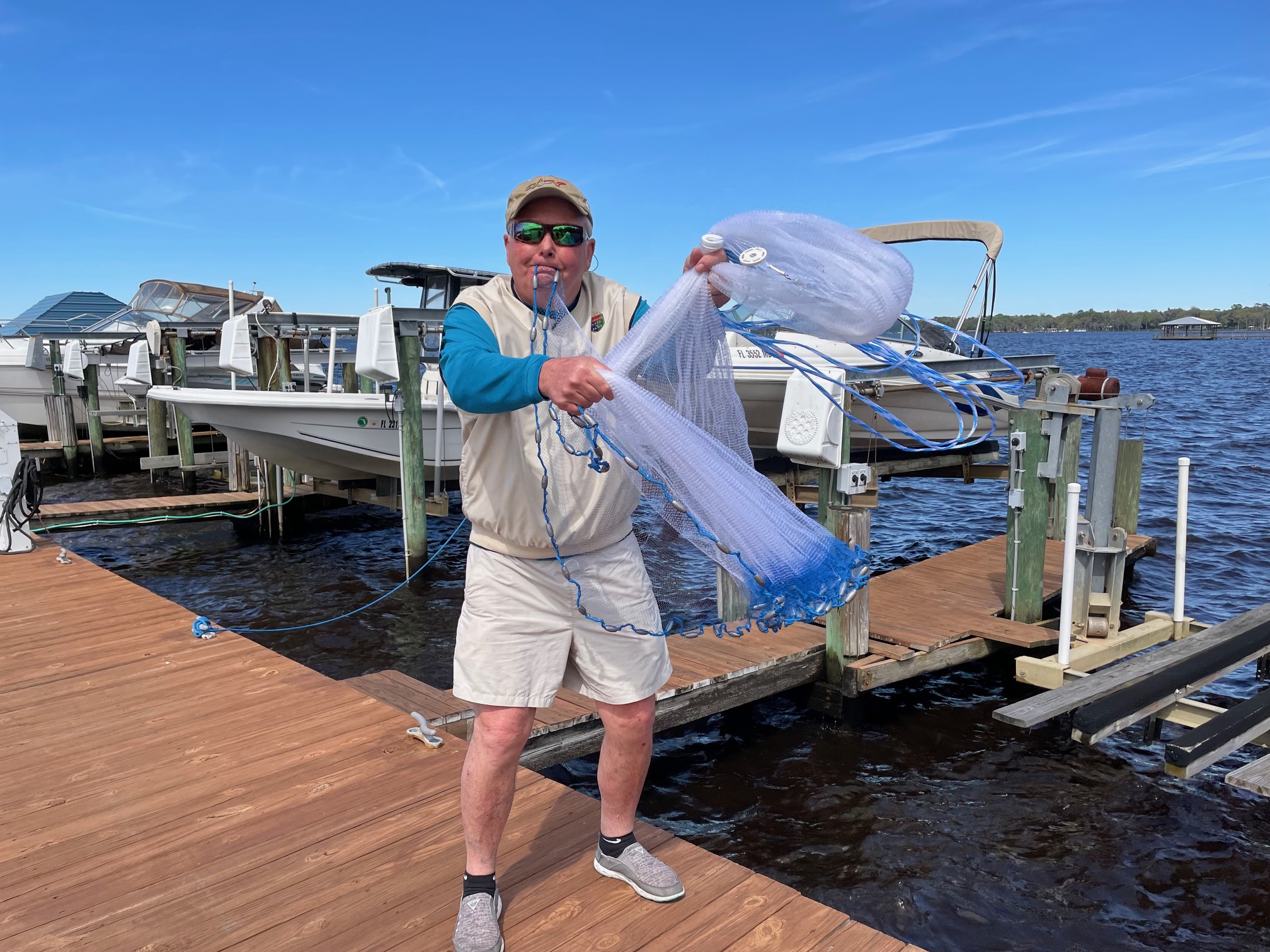
Bob McNally
This is an ideal net for shrimp and small minnow cast netting in shallow water. The two-piece horn is a little flimsy and unwieldy for me. But the horn has its braille wraps nicely protected under a rugged plastic cover. The barrel swivel connecting the brailles and hand line is rugged. However, the crimped metal sleeve over the brailles could be better protected if coated with a heavy plastic sleeve. This may seem unimportant, but this connection can take a beating in shallow water with lots of weeds and other unseen obstacles. The net opens well on the cast.
Throwing the net is easy. It’s indeed a “Super Spreader” and lays out flat when it hits the water. It sinks quickly in shallows and will be a terror for catching mullet, shiners, shad, and shrimp in 3 to 6 feet of water.
Read Next: Best Inshore Spinning Reels
Best Balanced and Fast-Sinking: Betts Hi Tider
Key Features
- Well-balanced for consistent easy opening
- Lead torpedo-shaped weights
- Hard-plastic utility storage box
- Rugged swivel connecting hand line to brailles
- Supple and easy to hold hand line
Pros
- At 5-pounds this net is joy to handle and throw
- It opens remarkably fast with little effort in the cast
- The net horn covers braille connections well to prevent chaffing in weeds and debris
- The nylon 3/8-inch fine-diameter mesh is soft and holds well in the hand
- Torpedo shaped leads get down fast, but resist fouling in weeds
- Green colored braille lines are easy to see, which can make tangles easier to deal with than if they were clear mono
- Plenty of braille lines for sure net opening and closing
Cons
- Sinkers in the lead line are not double stitched, which could be made more secure
- Utility box needs a handle for ease of holding and stowing
This is one of my favorite cast nets, simply because it’s very easy and fast to toss. That’s important when a school of bait is moving or suddenly pops up on the surface, and you’ve got to get a net out to them in a hurry. Because it’s so well balanced and simple to open, it’s a good one for “reaching” far back into weeds or between pilings and docks to cover bait. It will be a good one for stowing in a compact utility box under a boat seat or console, so it can be put into action in a hurry. For shrimp, finger mullet, shad, and shiners in water under about 5 feet, this is a go-to net.
Best For Beginners: Yeahmart Handmade American Saltwater Fishing Cast Net
Key Features
- High-density zinc sinkers
- Cushy foam wrist strap
- Separate accessory small mesh bag to hold caught bait
- Throwing instruction pamphlet
Pros
- At well under 3 pounds in weight, this a good one for small stature folks
- Due to its light weight, it opens fast and throws far
- For under $25 this is about the best price available for a serviceable 6-foot net
- Foam wrist strap is nice for newbie netters
Cons
- No utility case for easy carry
- Not a very durable horn
- Swivel connection of brailles to horn is small
- Brailles are very lightweight monofilament
- Lead line is not very rugged
- Weights are not double stitched to lead line
For the price of a decent restaurant dinner, this $24 cast net is one of the best deals a beginning throw net angler can find. No, it won’t sink as fast or be as durable as any other nets reviewed here. But this is a good one to start with. Mistakes are going to be made with beginning cast netters. Nets get tangled, they get tossed into places that rip and tear mesh, and that occurs with any net of any quality in almost any environment. Experience with casting nets helps avoid those inevitable problems. But if you’re going to rip and tear and tangle a net as you learn the ropes of the bait catching game, do it first with a less expensive, though functional, net like this one.
How to Choose a Cast Net
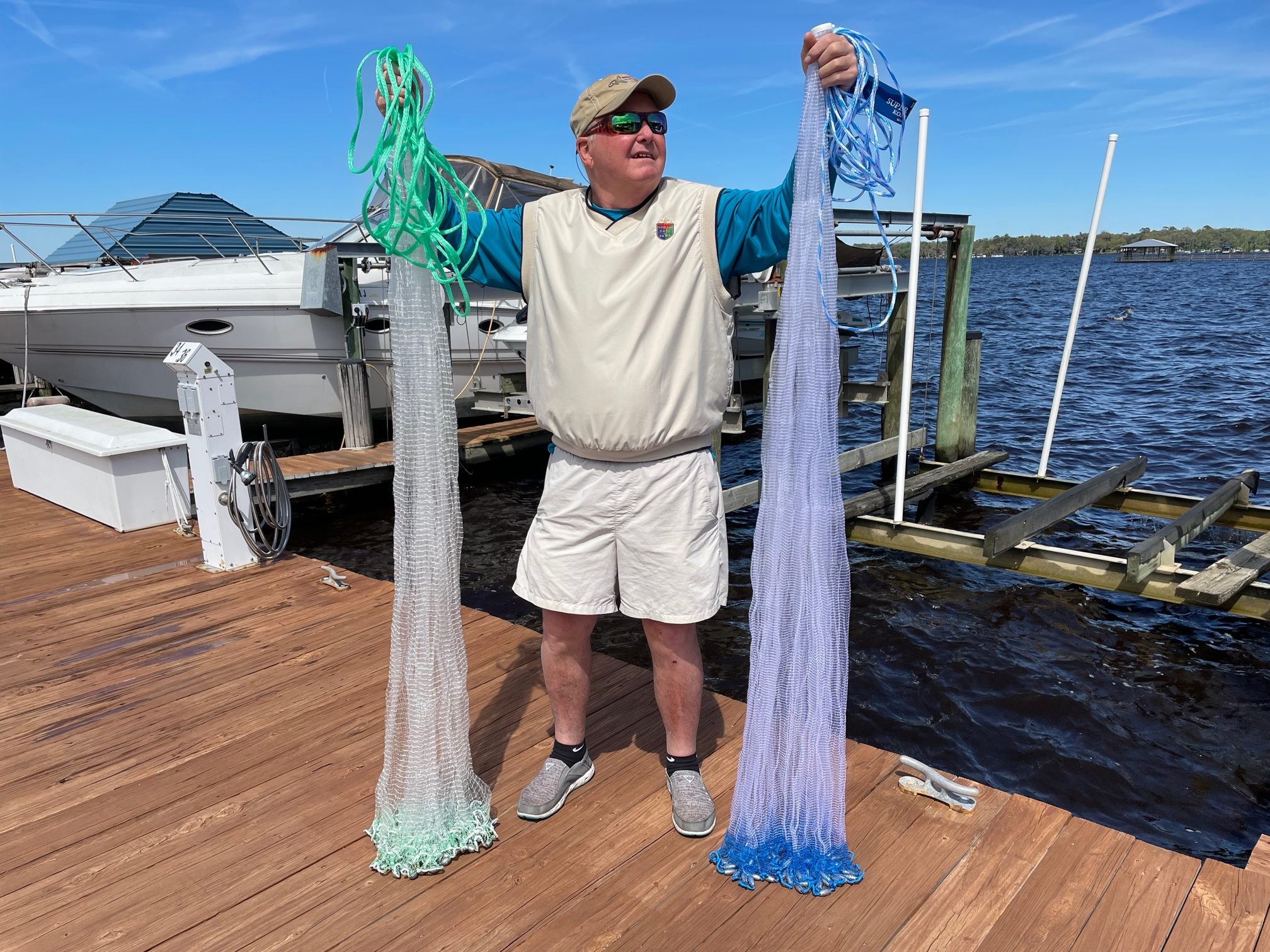
Bob McNally
While some anglers believe learning to use a cast net requires mythical guide-like expertise, throwing a net is simple, fun, and rewarding. The biggest decisions you’ll have to make when choosing a net are the size of the net, mesh, and weight. Here are some tips on making the right decision.
Cast nets come in a wide array of sizes (3 to 14 feet in length) and mesh dimensions (1/4-inch to over 1 inch). A good general-purpose net to start with is a 6-foot with ¼- to 1/2-inch mesh. This size net is suitable for a multitude of bait catching purposes, chiefly targeting small baitfish and shrimp from 3 to 8 inches or so in length.
Cast nets can be very focused in their design and customized for very specific needs. For example, nets used for catching large marine bait in deep water should be large (10 feet or more), have large mesh openings and heavy weights to allow them to sink fast in water 30 to 50 feet deep or more. However, for most bait-catching needs for the vast majority of anglers, smaller, modestly priced and sized nets suffice.
It’s helpful to understand that cast nets are measured by their overall radius, or vertical height from the top of the net to the bottom at the weight line. In use, however, a net unfurls in a circular fashion, and doubles the size of its height when thrown. So, a 6-foot radius cast net has a 12-foot diameter open mesh when it hits the water — usually more than adequate for capturing most bait.
Final Thoughts
Choosing the right net for your specific needs takes some thought, and sometimes some trail-and-error. But as a rule, you get what you pay for, and among good quality nets there’s not a lot of difference that most average anglers can perceive.
- Best Overall: Betts Super Pro Cast Net
- Best Bargain: Basic Gear Cast Net
- Best for Shallow Water: Fitec Super Spreader
- Best Balanced and Fast-Sinking: Betts Hi Tider
- Best for Beginners: Yeahmart Handmade American Saltwater Fishing Cast Net
